Still, everything that leads up to that frustratingly abrupt ending is terrific, making me hope that the full report doesn’t contain this information, then another 25 minutes of additional information but, instead, builds on what was said here to expose even more stuff. If you’ve been paying attention to the ever-growing hydra that is the Department of Homeland Security in the last ten years, then very little of the early stuff here—right down to the Catholic nuns who were investigated as possible security risks—will shock or surprise you. But the report builds from there, starting from the fascinating fact that the DHS has deputized America’s 800,000 police officers to keep an eye on literally anyone they come in contact with for “suspicious activity.” These officers then fill out reports on that suspicious activity, reports that enter the giant intelligence database tossed together by the DHS at assorted “fusion centers” throughout the country. (The little crawler that pops up every so often in Frontline’s one nod to modernity lets viewers know they can find their nearest fusion center at pbs.org. Just in case you, y’know, wanted to see what it looked like.)
The giant intelligence machine also gets fed by footage from security cameras and by, uh, police officers driving around, snappin’ photos of your license plate (among other things). From here, the report grows a little too chaotic, as Priest and the program’s editors ping pong between about a dozen, terrifying prospects but don’t really make any of those threats land. They visit a giant, intelligence operations show floor, where they talk to guys who try to sell them on various, privacy-invading gadgets. They hang out on the edges of giant, government complexes that disappear deep beneath the ground. They raise the alarming idea that literally no one knows just how much money is spent on the DHS every year and that no one quite knows just how much power the department has and what it’s allowed to do (much less what it’s doing with the information we DO know it has). And, again, the report concludes with the fact that recent terror plots have been foiled by an airplane passenger diving on the foiled underwear bomber, a suspicious street vendor calling in the foiled Times Square bomber, and someone lurking on Facebook noticing the guy who tried to blow up a military recruitment center. None of these successes had anything to do with the giant security apparatus. Indeed, the apparatus completely failed to notice the underwear bomber.
The thing about Frontline is that it can raise ideas like this (or like the ideas in the next segment, about potentially faulty airline procedures) and never seem like it’s an alarmist program, even if it sort of is. It’s always sober-minded, no matter how much it seems to be concern-trolling America, and that makes it easier to take the program when it’s engaging in the same sorts of calamity-minded muckraking that most other news magazines delve into. Take the next segment, “Flying Cheaper,” a special follow-up to an earlier report on problems in the airline industry. The segment more or less alleges that certain airlines (namely United) are taking the cheap, potentially dangerous, route on airline maintenance, and while it finds some intriguing evidence that all of this is happening and that all of it could lead to terrible, terrible calamity, it never finds the smoking gun that would make it must-see TV journalism. It’s tying together a bunch of things that SEEM to point to a certain conclusion but don’t necessarily point there. (My favorite part is when the reporter tries to get access to some of the off-site maintenance facilities and gets that permission, complete with a planned trip to China, then has the company cancel his visit just days before he’s due to arrive.) At the same time, I’m glad I’m not flying anytime soon.
So IS Frontline a step up from something like Dateline NBC? I’d still argue yes. The journalists at least show their work, instead of just leaning on the most television-friendly footage. The report on airlines doesn’t come up with anything conclusive, but it doesn’t try to say anything more than, “We’ve found all of this troubling stuff. Some people in the industry we talked to found it even more troubling. Maybe you’ll find it troubling too.” Or, hey, take the last segment, when Martin Smith travels to Afghanistan to talk to Amrullah Saleh, the former head of intelligence in that country. This is the sort of thing virtually no other news program in the U.S. would tackle. (MAYBE 60 Minutes. But that’s a big maybe.) And while Smith doesn’t get Saleh to crack much beyond vague threats of portent and doom, it’s still fascinating to just watch Saleh’s eyes. This is a guy who knows some heavy shit, and he’s still trying to put all of it in the right place. That’s Frontline in a nutshell. It doesn’t always get the big revelations (though it certainly knows what to do with them when it does), but it’s always suggesting something huge and world-shattering is just underneath the surface.
Stray observations:
- We’ve bandied adding Frontline here if there’s a small, vocal contingent that would watch the show and discuss it. We’d probably just add the full, hour-long editions, as the magazine show is much less documentary-like and, thus, much harder to review outside of just talking about what happened. So if you’d talk about the show on a 16-times-a-year basis, please let us know in comments!
- If you’d like to watch tonight’s episode, PBS.org is pretty good about putting Frontline episodes up for streaming, so check there. It makes excellent background noise for work.









































